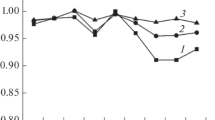Abstract
The technique of deposition of polymer films from the barrier gas discharge plasma on top of dielectric substrates is developed. The film precursor is a monomer material highly dispersed in a transport plasma gas. The plasma formation of the continuous polymer film can be divided into two stages. The first stage is deposition of liquid monomer droplets with subsequent polymerization on the dielectric barrier surface resulting in growth of a discontinuous film. It is found that the ratio of the height of droplets to their lateral size is almost constant and for polystyrene it is equal to ~0.01. The second stage is expansion of the droplets into islands and their coalescence into a continuous polymer film on the dielectric barrier surface. The polymer coating thickness and the amount of cross bonds essentially depend on the current density and concentration of the monomer in the transport discharge gas. A continuous polymer film, which is not contaminated with the monomer destruction products, can be obtained in the current density range of 7–25 mA/cm2. Experiments with several monomers, like methylmethacrylate, styrene and acrylonitrile, have shown that the growth rate is maximal for monomers with oxygen-free molecules. At the same time, a higher growth rate provides low cross-bond coatings, whereas to get high density of the cross-linked bonds one has to utilize low deposition rates. The minimal thickness at which continuity of the film is achieved increases when the monomer concentration in the plasma rises. In general, the coating thickness depends linearly on the discharge current density; the particular figures depend on the type and concentration of the monomer. The technological parameters are established and given for the three aforementioned monomers.
Similar content being viewed by others
References
Hegemann, D., Nisol, B., Watson, S., and Wertheimer, M.R., Energy conversion efficiency in plasma polymerization—a comparison of low-and atmospheric-pressure processes, Plasma Process. Polym., 2016, vol. 13, no. 8, pp. 834–842.
Bogoslov, E.A., Danilaev, M.P., Polsky, Yu.E., and Pudovkin, M.S., Formation of polystyrene film in gas discharge plasma at atmospheric pressure, Fiz. Khim. Obrab. Mater., 2016, no. 2, pp. 23–27.
Koshuro, V.A., Nechaev, G.G., and Lyasnikova, A.V., Effect of plasma processes of coating formation on the structure and mechanical properties of titanium, Fiz. Khim. Obrab. Mater., 2015, no. 2, pp. 35–41.
Zyn’, V.I., Oparin, V.B., Potapov, V.K., and Tuzov, L.S., Spatial distribution of polymerization processes in a glow discharge reactor, Khim. Vys. Energ., 1989, vol. 23, no. 3, pp. 276–281.
Palistrant, N.A., Kravets, L.I., Gilman, A.B., Bivol, V.V., Robu, S.V., and Barba, N.A., Study of the physicochemical properties of aminostyrene copolymers modified by plasma treatment, High Energy Chem., 2009, vol. 43, no. 4, pp. 324–329.
Ponomarev, A.N., Vasilets, V.N., and Tal’roze, R.V., Plasmochemical modification of polymers, Khim. Fiz., 2002, vol. 21, no. 4, pp. 96–102.
Thiry, D., Konstantinidis, S., Cornil, J., and Snyders, R., Plasma diagnostics for the low-pressure plasma polymerization process: a critical review, Thin Solid Films, 2016, vol. 606, pp. 19–44.
Aibatov, L.R., Orlov, V.V., Polsky, Yu.E., and Khokhlov, Yu.M., Analysis of a pulse generator operation in pre-ionization system of gas mixtures, Radiotekh. Elektron. (Moscow), 1986, vol. 31, no. 7, pp. 1352–1357.
Entsiklopediya nizkotemperaturnoi plazmy. Tom 2. Generatsiya plazmy i gazovye razryady. Diagnostika i metrologiya plazmennykh protsessov (Encyclopedia of a Low-Temperature Plasma, Vol. 2: Plasma Generation and Gas Discharges. Diagnostics and Metrology of Plasma Processes), Fortov, V.E., Ed., Moscow: Nauka, 2000.
Yasuda H.K. Plasma Polymerization, London: Academic, 1985.
Kudryashov, S.V., Perevezentsev, S.A., Ryabov, A.Yu., Shchegoleva, G.S., and Sirotkin, E.E., Study of the products of benzene transformation in the presence of argon, hydrogen, and propane-butane mixture in barrier discharge, Petrol. Chem., 2012, vol. 52, no. 1, pp. 60–64.
Spravochnik po kleyam (Handbook of Adhesives), Leningrad: Khimiya, 1980.
Author information
Authors and Affiliations
Corresponding author
Additional information
Original Russian Text © E.A. Bogoslov, M.P. Danilaev, Yu.E. Polskii, I.R. Vakhitov, A.I. Gumarov, I.V. Yanilkin, L.R. Tagirov, 2017, published in Fizika i Khimiya Obrabotki Materialov, 2017, No. 2, pp. 23–28.
Rights and permissions
About this article
Cite this article
Bogoslov, E.A., Danilaev, M.P., Polskii, Y.E. et al. Morphology of Polymer Film Coatings Produced in a Barrier Gas Discharge at Atmospheric Pressure. Inorg. Mater. Appl. Res. 9, 385–388 (2018). https://doi.org/10.1134/S2075113318030097
Received:
Accepted:
Published:
Issue Date:
DOI: https://doi.org/10.1134/S2075113318030097




